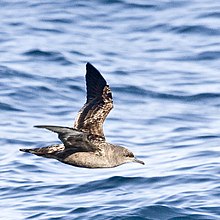Dark shearwater
| Dark shearwater | ||||||||||
|---|---|---|---|---|---|---|---|---|---|---|

Dark Shearwater ( Puffinus griseus ) |
||||||||||
| Systematics | ||||||||||
|
||||||||||
| Scientific name | ||||||||||
| Puffinus griseus | ||||||||||
| ( Gmelin , 1789) |
The dark shearwater ( Puffinus griseus ) belongs to the petrel family . It is a breeding bird in the southern hemisphere , but it is a regular migrant on the North Sea coast , which can be observed mainly in the months of August to November. The number of observations in the North Sea area has been increasing since the 1970s, which may be due to an improved food supply due to the increase in sprat and a change in the distribution of schools of young herring.
description
This bird is 40 to 50 cm long and has a wingspan of 95 to 110 cm. It has dark plumage and appears almost black in bad weather conditions. When the sun shines, you can see the dark gray to dark brown color and an additional silvery edge on the underside of the wings.
In flight, like other shearwaters, it constantly tilts from one side to the other and only flaps its wings a few times. With its powerful and straight flight, the bird is reminiscent of a greatly reduced albatross .
Distribution and migration behavior
The breeding areas of this species are located on small islands in the southern Pacific and southern Atlantic , especially around New Zealand , the Falkland Islands and Tierra del Fuego . The population is currently estimated at 20 million animals, but this number is decreasing significantly.
This shearwater is a migratory bird that completes a very long circular route every year. After the breeding season, which is completed between March and May, the migration goes north on the western side of the Pacific or Atlantic. In June or July subarctic waters are reached and the respective ocean is crossed from west to east. From September or October it goes back to the breeding areas on the east side, which are reached in November. The Atlantic route from the Falkland Islands to the North Atlantic off Norway alone is 14,000 kilometers. The bird was rarely seen in the Baltic Sea. The wintering areas of the New Zealand shearwaters are in the Aleutian Islands .
food
The dark shearwater feeds on fish and octopus and can dive up to 68 meters deep. Most of the time, the food is taken up in the upper water layers. These birds have been seen accompanying whales and fishing boats to catch frightened fish.
Reproduction
This bird breeds in large colonies and builds its nest in a hole in the ground that it only visits at night to avoid attacks by large seagulls .
additional
This bird is traditionally caught and eaten by the New Zealand Maori . The young birds are taken from the nests before they are able to fly. The meat is often salted for better storage. They are now on the market together with the short-billed shearwater as so-called Tasmanian youngsters in New Zealand. Catch quotas are intended to ensure that this has no impact on the stock.
The shearwater holds the world record among migratory birds. One specimen has been observed traveling 64,000 km per year. The bird also dived to depths of up to 68 meters.
swell
- ↑ Hans-Günther Bauer, Einhard Bezzel and Wolfgang Fiedler (eds.): The compendium of birds in Central Europe: Everything about biology, endangerment and protection. Volume 1: Nonpasseriformes - non-sparrow birds. Aula-Verlag Wiebelsheim, Wiesbaden 2005, ISBN 3-89104-647-2 , p. 218.
- ↑ Christopher M. Perrins (ed.): The BLV encyclopedia birds of the world. Translated from the English by Einhard Bezzel. BLV, Munich / Vienna / Zurich 2004, ISBN 978-3-405-16682-3 , p. 72 (title of the original English edition: The New Encyclopedia Of Birds. Oxford University Press, Oxford 2003).
Web links
- Videos, photos and sound recordings of Puffinus griseus in the Internet Bird Collection
- Ardenna grisea inthe IUCN 2013 Red List of Threatened Species . Listed by: BirdLife International, 2012. Retrieved October 13, 2013.
- Feathers of the dark tower diver
